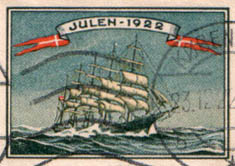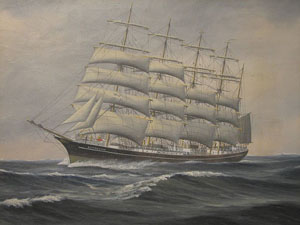
MORE ABOUT PT GERMEIN
|
They live in the curl of the breaking wave, They sing when the sea winds blow, They lie not confined in a land locked grave, Nor in dim, dark depths below. Do you hear them laugh in the rippling tide,
They live still in the hearts of those who wait
Noel Smith, Merchant Seaman |
ON THIS PAGE
The Ship
Cadet 1 Diary
Cadet 2 Diary
Voyages
The Unclaimed Letter
The Danish training ship, København, owned by the East Asiatic Company of Copenhagen, the largest sailing ship built in Britain, at Leith, a five master, arrived at Port Germein on New Year's Day, 1924 and stayed until January 15th, 1924. It is pictured below, loading wheat at Port Germein, in a photo provided by Robyn Holthouse. The photo belonged to Millicent Spencer, Robyn's Aunt and a long time resident of Port Germein.
Its figurehead, beautifully carved, was Absalon, the first Christian Bishop of Copenhagen, depicted with head high and carrying an axe. On the end
of the bowsprite was affixed a shark's tail to bring fair winds. The ship was 393 feet in length and carried 55,000 bags of wheat.
She carried 100 sails, including spares and when fully rigged she had 40 aloft on the five masts. In addition to the sails a 640 hp
diesel engine was installed.
(from 'Please Sir, Let's Do History,' text by Roy Parkes and pupils at Port Germein Primary School,
edited by Rita Purvis)
A "Visitor" to Port Germein briefly mentioned the arrival of the ship, in a long, flowery
article about New Year's Day at Port Germein, in 'The Recorder' of January 4th, 1924:
In the early morning the largest sailing ship in the world, the Kobenhaven, slowly entered the bay and anchored.
There were three large ocean-going steamers at anchor, and all the vessels had a good display of bunting.
With the smaller steamers plying between Port Pirie and Germein and white-winged craft sailing swiftly about,
an air of briskness and importance was given to the pretty scene. Officers from the vessels engaged in cricket
on the beach, a number of lascars mingled with the crowd, and seamen chattered in an unknown tongue.
Here is a list of the crew on the ship at Port Germein in January, 1924, with thanks to Thorbjørn Thaarup of the Danish Maritime Museum. Many of the cadets were from wealthy or even noble families, as learning about the sea on a sailing ship was compulsory for a ship's officer in the merchant marine. When the ship was in Port Germein, a ball was held aboard, which is mentioned in the diaries below.
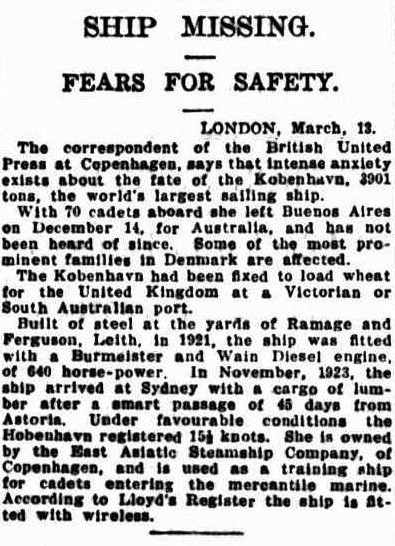 There were cadets on board as it was a training ship. The townspeople entertained them, and I remember
my parents telling the story of having two of the cadets on the farm for the day. Unfortunately, the ship
There were cadets on board as it was a training ship. The townspeople entertained them, and I remember
my parents telling the story of having two of the cadets on the farm for the day. Unfortunately, the ship
Brenda Leitch
The ship was on a journey from Buenos Aires to Australia, leaving on December 14, 1928, headed for Melbourne and Adelaide.
When it disappeared the Australian interstate steamer,'Junee,' not much bigger than a Manly ferry, was fitted with
auxiliary sails and sent on a prolonged search for 'København.' No trace was found and 'Junee' was lucky to survive. Without the sails she would have been in serious trouble.
The Danish tanker, 'Mexico,' searched, funded largely by relatives of the missing men.
'SS Deucalion,' tanker 'Panama' and 'SS Beltana' also participated in the hunt.
Noel Smith
If you click on this underwriting link you will see a copy of a survey note from 'København.' The document was found in the old harbour master's office at Pt Germein and donated to the Port Pirie Museum where it was supposed to be framed and exhibited. Sadly that didn't happen and it was lost for many years before being found in this badly degraded condition. Noel Smith was able to get a copy. The steel vessel, owned by the East Asiatic Co. Ltd and under the Danish flag had arrived from Sydney on the first of January, 1924. It was surveyed while afloat on January 3rd, 1924
Ships of the East Asiatic line| Danish Maritime Museum|East Asiatic Company|
Australian News about the København.
On our recent visit (July 2015) to the new Ship Museum in Helsingør, I was disappointed to see so little on display
about the København, because I know they have a lot of very interesting material.
The place, built inside an old shipyard and next to the castle, looks fabulous and is probably one of the coolest places I have ever been in my life.
The displays were sensational and interactive and I am sure would appeal to all,
especially the young, but I couldn't help feeling that functionality has been sacrificed for appearance. It seems amazing that you would build a new place specifically for
displaying ship history and then have to store many of your artefacts like model ships elsewhere. With so much room, couldn't storage have been made on site as well?
I know that displays will be changed at regular intervals and that they probably ran out of money, but how you look is not the only thing that matters. I was, however, lucky to find
one good film about the ship in a series of 3 films about shipping disasters.
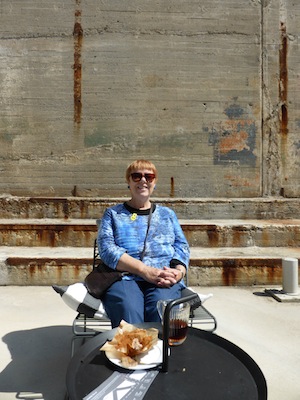 The same comment applies to the souvenir/gift shop. While having designer nautical themed clothes may appeal to some of the visitors, most ordinary people
like us are not going to want to pay $100 or so for a top. They should have some cheaper but tasteful and relevant souvenirs. There were not even that many books about ships.
I did buy a DVD about "L'Avenir" and they had the DVD about the " København" too which was excellent.
The same comment applies to the souvenir/gift shop. While having designer nautical themed clothes may appeal to some of the visitors, most ordinary people
like us are not going to want to pay $100 or so for a top. They should have some cheaper but tasteful and relevant souvenirs. There were not even that many books about ships.
I did buy a DVD about "L'Avenir" and they had the DVD about the " København" too which was excellent.
I really felt the need to revisit all the information about the
København on our return to Australia, and so I went back to TROVE and corrected and compiled the news stories in text form. I note that several other people
are editing the stories too and probably feel the same fascination. There is so much information, not all of it accurately spelt or even correct and much of it repeated,
but it does build up to a compelling story.
I see that there was a return to Tristan Da Cunha in 2012 examining wreckage that has been found.
The Danish Maritime Museum seems to be involved so I am hoping that there may be news eventually.
I have included a few of the better
newspaper pictures related to the stories. All are from Australian newspapers.
Australian News about the København in regular text.
KØBENHAVN DIARIES
Here are the diaries of two young cadets on the Skoleskib (school ship) 'København' docked in Port Germein,
South Australia from January 1st, 1924 to January 15th, 1924.
The pictures are from the picture archive of the Danish Maritime Museum and come from an album belonging to the widow of a
former sailor on the ship, Henry Peter Berg. The photos are not labelled but I believe that the ones shown were very probably
taken at Port Germein. I know that the cadets did go to the Pt Germein Gorge and were also
taken out to farms nearby for a day.
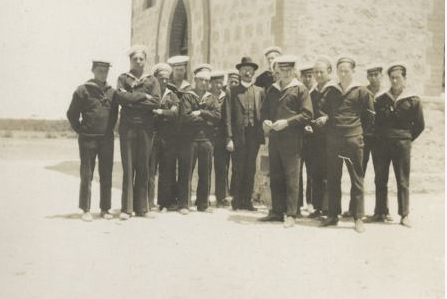 CADET 1
CADET 1
False Bay Sunday 30 December 1923
I cleaned the cabins at the aft of the ship. For the rest of the
day we had free time. Some of those from the front of the ship were out rowing in the number 3 boat.
False Bay Monday 31st December 1923
I cleaned cabins aft of the ship and was down in the ballast the rest of the day.
False Bay Tuesday 1 January 1924
In the morning we pulled up anchor and sailed over to Germany Bay at around 6 o'clock, where we dropped
anchor around 9 o'clock. In the morning we washed down the hold.
(At the side, Germany has been corrected as Germein, apparently by the sailor himself and beneath the instructor has written 'Germein, Port Germein'
and signed it)
Sct Germein Wednesday, 2 January
In the morning we pulled up anchor and sailed in to the long jetty, which is 1 1/2 miles long.
I was cabin boy aft and polished brass in the Second Mate's cabin.
(Sct. is corrected to Port)
Sct Germein Thursday 3 January
I was cleaning cabins down aft and in the afternoon I was polishing brass in the teacher's cabin. The
ship is being readied for loading and they have started at the number 4 hatch.
Sct Germein Friday 4 January
I was cleaning cabins and had the First Engineer's and First Mate's carpets out for airing and after that
I was polishing brass in the Second Engineer's cabin
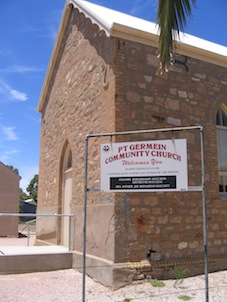 Sct Germein Saturday 5 January
Sct Germein Saturday 5 January
I cleaned the cabins aft and polished brass in the First mate's cabin. After midday the cadets rigged
the Fall sail and then there was free time.
Sct Germein Sunday 6 January
We performed morning cleaning and then we had free time. At 9 o'clock Treshauw, (C T Treschow), Tritjof(?) and I
went on a walk to find something unusual. There were many visitors on board.
Sct. Germein Monday 7 January
I had watch duty on the gangway from 6-8.30 and the captain spoke to us after lunch, and our duties were changed.
I was moved up to the second oldest class. I was down in the hull in the afternoon.
Port Germein Tuesday 8 January
We peformed morning cleaning and after lunch I was down in the middle deck to remove spots on the ship's side.
After coffee time we tidied up the deck and at 5 o'clock we knocked off.
Port Germein Wednesday 9 January
We performed morning cleaning and after lunch I was on watch duty on the gangway till 12.30 and after lunch
I was down removing spots again. After coffee time we tidied up. I had watch duty on the gangway from 12 to 2 at night.
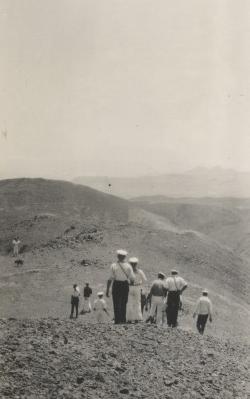 Port Germein Thursday 10 January
Port Germein Thursday 10 January
We carried out morning cleaning and then had gangway watch duty. Off duty the rest of the day. I was up in the mountains.
Port Germein Friday 11 January
We carried out morning cleaning and then cleaned up spots on the shipside on the middle deck. From 12.30
to 3.30 I had gangway duty. After coffeee break I was tidying up the deck. I had watch duty from 10-12.
Port Germein Saturday 12 January
We carried out morning cleaning and before lunch we sand scrubbed the aft deck and after lunch we decorated the aft deck
because there was going to be a ball in the evening.
Port Germein Sunday 13 January
We carried out morning cleaning and then we had free time. There were many visitors on board. I had gangway duty 12.30 to 3.30.
Port Germein Monday 14 January
We carried out morning cleaning and then I was down on the middle deck binding mats,
and in the afternoon I was tidying up the middle deck. We were at school from 3.30 to 5.00. At 8 o'clock we had completed loading.
Port Germein Tuesday 15 January
In the morning we loaded coal, and around 8 o'clock we pulled up anchor and sailed to Port
Victoria. In the afternoon all sails were set on the main mast, except the main sail, and the engine was stopped.
On the evening shift, the team on duty took all sails down. On the 4-8 shift the stay sails were raised again.
CADET 2
False Bay Tuesday 1 January 1924
In the morning we left and sailed over to germain Bay where we dropped anchor close to 'Bolivia.' The cargo hold was hosed down.
Germain Bay Wednesday 2 January
Around 7.00-7.30 we left and sailed into a very long jetty. I was on the motor boat that pulled the hawsers in.
Germain Thursday 3 January
We started loading in the number 3 hatch. We were still working on getting the cargo hull ready.
The ballast tanks were emptied.
Germain Friday 4 January
We worked in the front cargo hull, tossing boards up on to the middle deck. Apart from that we were polishing brass,
I was polishing the light houses.
Germain Saturday 5 January
We were polishing brass in the morning. I was polishing for the under officers. After lunch we knocked off.
Germain Sunday 6 January
We tidied up the deck and polished brass, then we knocked off.
Germain Monday 7 January
In the morning I worked in the front cargo hull, preparing it for loading. In the afternoon I was on gangway duty.
Germain Tuesday 8 January
In the morning we were painting. At 10 o'clock we went to school. In the afternoon I continued painting.
Germain Wednesday 9 January
In the morning I was on gangway duty. The outside of the ship was being painted. The middle top sail was being dried.
Germain Thursday 10 January
We had free time from 8 o'clock. In the morning I was tidying the sailors' area.
Germain Friday 11 January
In the morning I had gangway duty. Before lunch I went ashore to help with carting sand to the ship's sandbox.
After lunch we were washing the aft deck.
Germain Saturday 12 January
First thing in the morning I was working down in the ballast tanks, they had to be hosed clean.
We finished with them around 3 o'clock. The aft deck was being sand scrubbed, the brass polished and the deck was
being decorated with flags, because there was going to be a ball in the evening.
Germain Sunday 13 January
In the morning I was cleaning the aft hallways, then I had free time. I had gangway duty 3.30 to 6.00.
Germein Monday 14 January
In the morning I was cleaning the sailors' area. We had school from 10-12 and after lunch I was tidying up
on the middle deck, and filled water in the freshwater tanks. Around 9 o'clock we finished loading.
Germein Tuesday 15 January
In the morning we loaded coal, and just before 8 o'clock we pulled up anchor and sailed.
I had rudder duty from 9-10. After lunch the roster was set, we got the afternoon shift and I had rudder duty
12.30-2, 3.30-5 and 6-7. We set all the sails on the main mast, apart from the main sail, and on the top front we set the jib.
On the evening shift they set the mizzen mast. The square sails and stay sails were taken down again on the evening shift.
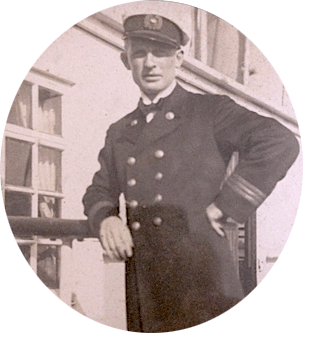 Wednesday 16 January
Wednesday 16 January
At 8 o'clock we tidied up the middle deck. Around 10 o'clock we rigged the fall rope out over starboard and around
11 o'clock we dropped anchor outside Port Victoria.
Thursday 17 January
In the morning I had gangway duty from 8.30-12.30. We started loading from a steamer that had been next to us since morning.
In the afternoon I worked in the cargo hull setting up mats.
Port Victoria Friday 18 January
I helped hosing and cleaning the under tank. In the afternoon we were setting up mats in the cargo hull.
We were still loading from the steamer.
The diaries are written in cursive and quite difficult to translate in places because of handwriting style, shipping terms, abbreviations and some errors in punctuation. Obviously a school type exercise, the diaries have been marked and corrected but in some places the cadets have corrected themselves, not crossing out but using brackets or writing in the margin. We have tried to translate them as faithfully as possible, including obvious errors like the spelling of Port Germein which is confused with Saint Germain. It seems they were not encouraged to see much of the local area but were kept on board polishing and scrubbing. While the diaries give an idea of their daily routine, there is no personal comment.
We were kindly given photocopies at the Danish Maritime Museum at Kronberg Castle, Helsingør, Denmark. A wealth of material available there is still being catalogued and studied.
2 Photos Above: The photo was labelled, Funder, unknown, Emdel. The hat band says KØBENHAVN, so these were cadets at Port Gemein: Captain Hans Ferdinand Andersen, master on the last fateful voyage of the 'København'VOYAGES OF THE KØBENHAVN
The 'København' made 8 voyages from 1921 to 1928 but sadly disappeared on the 9th/10 trip, from Buenos Aires to Australia.
On the crew lists of the voyages were hand written, in cursive, the ports visited during each trip, and I thought
it interesting to record them, but it has been difficult to decipher some of the names, especially since ports well
known to sailors then are not necessarily well known to us now. Sometimes only the arrival or departure date was marked on the lists,
not the overall time spent at a stop. Extra information has come from an account of the ship's journeys and history by
Hanne Poulsen (received March, 2011) and translated using Google. Here is an index card of some of the voyages
from maritime records in San Francisco.
TRIP 1 PACIFIC-EAST
|
TRIP 2 SOUTH AMERICA
|
TRIP 3 NORTH PACIFIC-AUSTRALIA
|
TRIP 4 SOUTH-AFRICA
|
TRIP 5 BANGKOK-SINGAPORE
|
TRIP 6 Australia-Easterly again via Cape
|
TRIP 7 AUSTRALIA-LIVERPOOL
|
TRIP 8 WEST COAST-SOUTH AMERICA
|
TRIP 9, 10 BUENOS AIRES-AUSTRALIA
| |
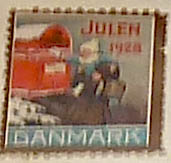
Here is a Christmas letter about day to day life, written to one of the sailors aboard "København" for Christmas, 1928, and delivered to Australia in anticipation of the arrival of the ship, which never came. The mail was eventually returned to Denmark. The letter bears a 1928 julemaerke, the decorative stamp sold at Christmas to aid charity.
Diary page created 30-1-2011 by L. Nordestgaard; Updated 25-7-2015. Links checked 9-4-2025
